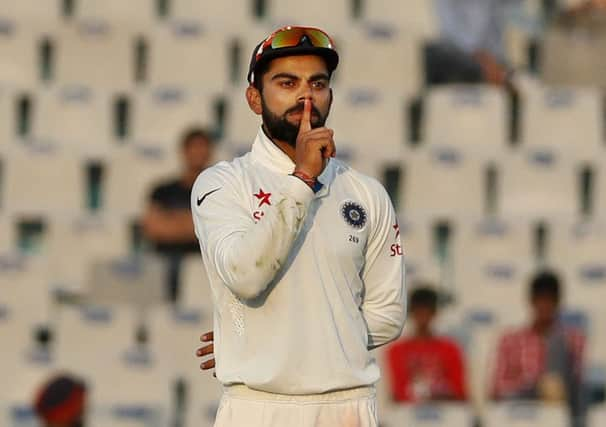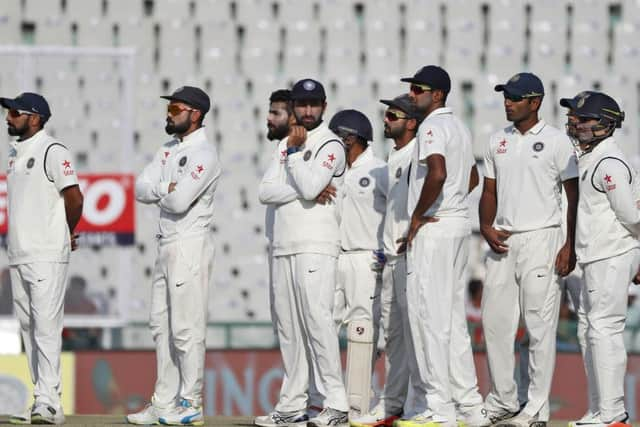Chris Waters: Nightmare scenario on horizon with Test trackers


According to the laws of cricket, an incoming batsman must be in position to take guard, or his partner ready to receive the next ball, within three minutes of the previous batsman’s dismissal.
By my calculations, around five minutes passed while we waited to find out whether England captain Alastair Cook was lbw to Ravindra Jadeja after India reviewed umpire Marias Erasmus’s not out decision on the field.
Advertisement
Hide AdAdvertisement
Hide AdWhile the initial components of DRS were instantly available, enabling Kumar Dharmasena, the third umpire, to confirm that it was a fair delivery and that Cook had not hit the ball, the ball-tracking mechanism developed a glitch.


Ball-tracking – which predicts whether a ball would have gone on to hit the stumps after striking the pad – is normally the most important part of the DRS procedure, but the system took an eternity to generate footage for Dharmasena to view.
Consequently, the players stood on the field, hands in pockets, staring up at the big screen in increasing bewilderment, waiting on the eventual outcome.
Finally, the footage appeared and Erasmus’s judgement was vindicated, showing that the ball would have gone on to miss Cook’s leg stump.
Advertisement
Hide AdAdvertisement
Hide AdIn the grand scheme of things, it mattered not a jot; Cook, who had nine runs at the time, added only three more before being bowled by Ravi Ashwin.


But one can easily imagine the reaction had the system failed completely at the time, only for it later to have been shown that Cook was actually out before going on to make a match-winning hundred.
It is safe to assume that India’s long-standing opposition to DRS would only have intensified in a series in which their governing body have only assented to its use on a trial basis.
As BCCI president Anurag Thakur confirmed before the opening Test: “Based on the performance of the system and the feedback that we will receive, further continuation in forthcoming series will be decided.”
Advertisement
Hide AdAdvertisement
Hide AdThe glitch in the ball-tracking system at least provided some amusing comments among pundits and on social media.
“Has the guy running the technology gone for a cup of tea?” wondered Michael Vaughan on Test Match Special.
On Twitter, someone posted: “Just redecorated the house while waiting for the outcome of this review”, while another quipped: “Met a girl, fell in love, married and divorced while they built that DRS.”
For Cook, it must have been a torturous five minutes as he waited for the television judgement.
Advertisement
Hide AdAdvertisement
Hide AdDRS has been in the spotlight a lot recently, with a record 26 reviews in the Test match between Bangladesh and England in Chittagong last month.
Dharmasena was one of the on-field umpires in that game and, of his 16 decisions, eight were overturned, the highest number of reversed decisions for an umpire in a Test.
The experience seems to have affected the Sri Lankan, who almost dropped another clanger on the second day of the ongoing match.
After Erasmus gave Parthiv Patel caught behind off Chris Woakes, replays showed that the ball missed the bat and brushed Patel’s shirt, meaning that he was, therefore, not out.
What happened next beggared belief.
Advertisement
Hide AdAdvertisement
Hide Ad“Marias, no edge,” said Dharmasena to his on-field colleague.
“You can stay with your original decision.”
Luckily, Erasmus did not hear the second part of that comment and overturned his initial verdict.
Once again, social media exploded, with one wag wondering: “Is it allowed to review Dharmasena’s decisions when he’s the third umpire?”
Not that India were entirely ungrateful for DRS yesterday.
In the closing moments, they successfully reviewed when Ben Stokes was given not out after being struck on the pad by Ashwin, who squared him up with a delivery that would have gone on to hit off stump.
Advertisement
Hide AdAdvertisement
Hide AdNo sooner had the big screen confirmed Stokes’s demise when Virat Kholi raised his finger to his lips in mock silence in a continuation of the ongoing childishness between the pair.
For those unfamiliar with this tedious spat, Kholi gave Stokes a send-off when the Englishman was dismissed in the first innings, and Stokes, reprimanded by the International Cricket Council for responding with a few verbals, then pointedly covered his mouth after dismissing Kholi on day two.
Sunil Gavaskar, the former India batsman, was among those who criticised Kholi’s behaviour yesterday, saying that the situation needs to be “nipped in the bud”.
Alas, we are moving ever closer to a nightmare scenario.
Namely, a sport played with no on-field umpires and classless players engaging in increasing numbers of verbals and send-offs.